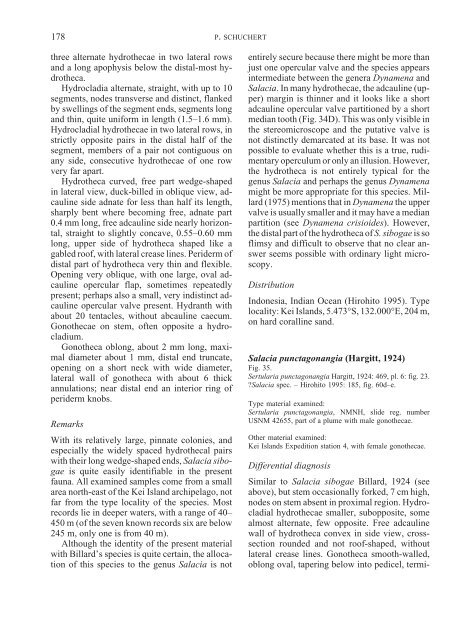Hydroids (Cnidaria, Hydrozoa) of the Danish expedition to
Hydroids (Cnidaria, Hydrozoa) of the Danish expedition to
Hydroids (Cnidaria, Hydrozoa) of the Danish expedition to
Create successful ePaper yourself
Turn your PDF publications into a flip-book with our unique Google optimized e-Paper software.
178<br />
three alternate hydro<strong>the</strong>cae in two lateral rows<br />
and a long apophysis below <strong>the</strong> distal-most hydro<strong>the</strong>ca.<br />
Hydrocladia alternate, straight, with up <strong>to</strong> 10<br />
segments, nodes transverse and distinct, flanked<br />
by swellings <strong>of</strong> <strong>the</strong> segment ends, segments long<br />
and thin, quite uniform in length (1.5–1.6 mm).<br />
Hydrocladial hydro<strong>the</strong>cae in two lateral rows, in<br />
strictly opposite pairs in <strong>the</strong> distal half <strong>of</strong> <strong>the</strong><br />
segment, members <strong>of</strong> a pair not contiguous on<br />
any side, consecutive hydro<strong>the</strong>cae <strong>of</strong> one row<br />
very far apart.<br />
Hydro<strong>the</strong>ca curved, free part wedge-shaped<br />
in lateral view, duck-billed in oblique view, adcauline<br />
side adnate for less than half its length,<br />
sharply bent where becoming free, adnate part<br />
0.4 mm long, free adcauline side nearly horizontal,<br />
straight <strong>to</strong> slightly concave, 0.55–0.60 mm<br />
long, upper side <strong>of</strong> hydro<strong>the</strong>ca shaped like a<br />
gabled ro<strong>of</strong>, with lateral crease lines. Periderm <strong>of</strong><br />
distal part <strong>of</strong> hydro<strong>the</strong>ca very thin and flexible.<br />
Opening very oblique, with one large, oval adcauline<br />
opercular flap, sometimes repeatedly<br />
present; perhaps also a small, very indistinct adcauline<br />
opercular valve present. Hydranth with<br />
about 20 tentacles, without abcauline caecum.<br />
Gono<strong>the</strong>cae on stem, <strong>of</strong>ten opposite a hydrocladium.<br />
Gono<strong>the</strong>ca oblong, about 2 mm long, maximal<br />
diameter about 1 mm, distal end truncate,<br />
opening on a short neck with wide diameter,<br />
lateral wall <strong>of</strong> gono<strong>the</strong>ca with about 6 thick<br />
annulations; near distal end an interior ring <strong>of</strong><br />
periderm knobs.<br />
Remarks<br />
With its relatively large, pinnate colonies, and<br />
especially <strong>the</strong> widely spaced hydro<strong>the</strong>cal pairs<br />
with <strong>the</strong>ir long wedge-shaped ends, Salacia sibogae<br />
is quite easily identifiable in <strong>the</strong> present<br />
fauna. All examined samples come from a small<br />
area north-east <strong>of</strong> <strong>the</strong> Kei Island archipelago, not<br />
far from <strong>the</strong> type locality <strong>of</strong> <strong>the</strong> species. Most<br />
records lie in deeper waters, with a range <strong>of</strong> 40–<br />
450 m (<strong>of</strong> <strong>the</strong> seven known records six are below<br />
245 m, only one is from 40 m).<br />
Although <strong>the</strong> identity <strong>of</strong> <strong>the</strong> present material<br />
with Billard’s species is quite certain, <strong>the</strong> allocation<br />
<strong>of</strong> this species <strong>to</strong> <strong>the</strong> genus Salacia is not<br />
P. SCHUCHERT<br />
entirely secure because <strong>the</strong>re might be more than<br />
just one opercular valve and <strong>the</strong> species appears<br />
intermediate between <strong>the</strong> genera Dynamena and<br />
Salacia. In many hydro<strong>the</strong>cae, <strong>the</strong> adcauline (upper)<br />
margin is thinner and it looks like a short<br />
adcauline opercular valve partitioned by a short<br />
median <strong>to</strong>oth (Fig. 34D). This was only visible in<br />
<strong>the</strong> stereomicroscope and <strong>the</strong> putative valve is<br />
not distinctly demarcated at its base. It was not<br />
possible <strong>to</strong> evaluate whe<strong>the</strong>r this is a true, rudimentary<br />
operculum or only an illusion. However,<br />
<strong>the</strong> hydro<strong>the</strong>ca is not entirely typical for <strong>the</strong><br />
genus Salacia and perhaps <strong>the</strong> genus Dynamena<br />
might be more appropriate for this species. Millard<br />
(1975) mentions that in Dynamena <strong>the</strong> upper<br />
valve is usually smaller and it may have a median<br />
partition (see Dynamena crisioides). However,<br />
<strong>the</strong> distal part <strong>of</strong> <strong>the</strong> hydro<strong>the</strong>ca <strong>of</strong> S. sibogae is so<br />
flimsy and difficult <strong>to</strong> observe that no clear answer<br />
seems possible with ordinary light microscopy.<br />
Distribution<br />
Indonesia, Indian Ocean (Hirohi<strong>to</strong> 1995). Type<br />
locality: Kei Islands, 5.473°S, 132.000°E, 204 m,<br />
on hard coralline sand.<br />
Salacia punctagonangia (Hargitt, 1924)<br />
Fig. 35.<br />
Sertularia punctagonangia Hargitt, 1924: 469, pl. 6: fig. 23.<br />
?Salacia spec. – Hirohi<strong>to</strong> 1995: 185, fig. 60d–e.<br />
Type material examined:<br />
Sertularia punctagonangia, NMNH, slide reg. number<br />
USNM 42655, part <strong>of</strong> a plume with male gono<strong>the</strong>cae.<br />
O<strong>the</strong>r material examined:<br />
Kei Islands Expedition station 4, with female gono<strong>the</strong>cae.<br />
Differential diagnosis<br />
Similar <strong>to</strong> Salacia sibogae Billard, 1924 (see<br />
above), but stem occasionally forked, 7 cm high,<br />
nodes on stem absent in proximal region. Hydrocladial<br />
hydro<strong>the</strong>cae smaller, subopposite, some<br />
almost alternate, few opposite. Free adcauline<br />
wall <strong>of</strong> hydro<strong>the</strong>ca convex in side view, crosssection<br />
rounded and not ro<strong>of</strong>-shaped, without<br />
lateral crease lines. Gono<strong>the</strong>ca smooth-walled,<br />
oblong oval, tapering below in<strong>to</strong> pedicel, termi-

















